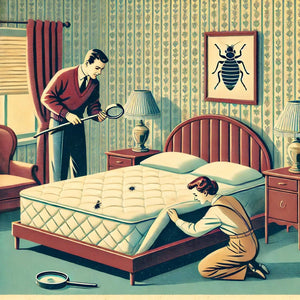Bed Bug Infestation Signs: How to Spot These Unwanted Guests
Bed Bug Infestation Signs: How to Spot These Unwanted Guests
Bed bugs are notorious hitchhikers that can quickly turn your home into their playground. Recognizing the signs of a bed bug infestation early is crucial for swift and effective treatment. In this blog, we'll explore the key indicators that suggest you might be dealing with these pesky invaders [1].
Visual Clues of Bed Bug Presence
One of the most obvious bed bug infestation signs is spotting the insects themselves. Adult bed bugs are about the size of an apple seed, with a reddish-brown, oval-shaped body [1]. However, these nocturnal pests are experts at hiding, so you'll need to look closely in the following areas:
- Mattress seams and corners
- Box spring edges
- Headboard crevices
- Furniture joints and cracks
- Baseboards and wall outlets
Telltale Stains and Spots
Bed bug infestation signs often include distinctive stains on your bedding and furniture [1][2]:
- Rusty or reddish-brown spots on sheets and mattresses, which are actually dried blood stains from crushed bed bugs
- Dark spots about the size of a period, which are bed bug excrement
- Pale yellow eggshells and shed skins in hiding spots
These stains are typically found along mattress seams, upholstered furniture seams, and other areas where bed bugs congregate.

Bites and Skin Reactions
While not a definitive indicator, unexplained bites can be one of the bed bug infestation signs to watch for [2][4]:
- Small, red, itchy bumps on exposed skin
- Bites often appear in a line or cluster
- Some people may develop an allergic reaction, resulting in larger welts
Remember that not everyone reacts to bed bug bites, and reactions can vary significantly between individuals.
Unusual Odors
A large bed bug infestation may produce a distinct odor [1][5]:
- Often described as sweet or musty
- Similar to the scent of coriander or almonds
- More noticeable in heavily infested areas
Physical Evidence
As bed bugs grow and multiply, they leave behind physical traces [1][3]:
- Shed exoskeletons or molted skins
- Tiny white eggs (about 1mm in size)
- Live bed bugs in various life stages
Using Active Monitors
For a more proactive approach to detecting bed bug infestation signs, consider using [4]:
- Chemical lure traps
- CO2 monitors
- Climb-up Traps
These devices can help confirm the presence of bed bugs, especially in the early stages of an infestation.
Conclusion: Act Quickly on Bed Bug Infestation Signs
Identifying bed bug infestation signs early is key to preventing a full-blown infestation. If you notice any of these indicators, it's crucial to act quickly [1][4]:
- Thoroughly inspect your living space
- Isolate potentially infested items
- Contact a professional pest control service for a comprehensive inspection and treatment plan
Remember, bed bugs are resilient and can spread quickly. The sooner you address the problem, the easier and less costly it will be to eliminate these unwanted guests from your home.
By staying vigilant and knowing what to look for, you can protect your living space from these persistent pests. Regular inspections and prompt action at the first bed bug infestation signs are your best defense against a full-scale invasion.


